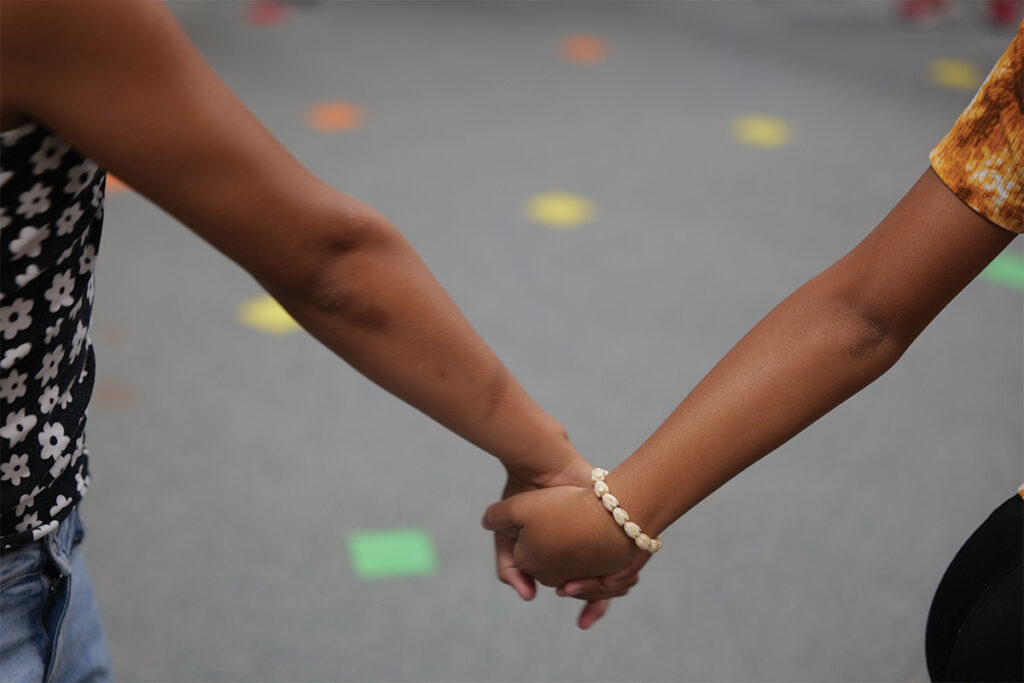Our Hawaiʻi public schools believe every student deserves a safe, respectful learning environment—both in school and online. Bắt nạt, in any form, undermines the well-being and success of students. That’s why we are committed to empowering students, families and communities with tools and resources to prevent and address bullying. From proactive prevention programs to easy-to-use reporting tools like the Ứng dụng Speak Now HIDOE, chúng tôi hợp tác chặt chẽ với cộng đồng của mình để thúc đẩy văn hóa tôn trọng, trách nhiệm và đồng cảm. Cùng nhau, chúng tôi có thể đảm bảo mọi học sinh đều cảm thấy được hỗ trợ và an toàn, để các em có thể phát triển về mặt học thuật và tình cảm.

What is Bắt nạt?
Bắt nạt is a serious issue that affects students of all ages and backgrounds. While there are many forms of bullying, we’ll be focusing on two primary categories: bullying Và cyberbullying. Understanding these two types is important so we can all work together to create a safer and more respectful school environment.
“Bullying”—bất kỳ hành vi bằng văn bản, lời nói, đồ họa hoặc hành động nào gây tổn thương, làm hại, làm nhục hoặc đe dọa học sinh, bao gồm cả những học sinh có tình trạng được bảo vệ, có mức độ nghiêm trọng, dai dẳng hoặc lan rộng đến mức tạo ra môi trường giáo dục đe dọa, uy hiếp hoặc lạm dụng.
“Cyberbullying”—electronically transmitted acts, including but not limited to those transmitted through the Internet, cell phone, or other wireless hand-held device initiated by one student toward another student or employee of the department that hurts, harms, humiliates, or intimidates the student or employee; and is sufficiently severe, persistent or pervasive, that it creates an intimidating, threatening, or abusive educational environment. Cyberbullying can occur:
- Trong khuôn viên trường hoặc các cơ sở khác của khoa, trên phương tiện giao thông của khoa hoặc trong hoạt động hoặc sự kiện do khoa tài trợ trong hoặc ngoài khuôn viên trường;
- Thông qua hệ thống dữ liệu của sở mà không có sự liên lạc được sở cho phép; hoặc
- Thông qua mạng máy tính ngoài trường, nếu hành vi đó ảnh hưởng đến môi trường giáo dục.
Additionally, cyberbullying may also be based on a person’s protected class, including but not limited to, a person’s race, color, religion, sex, sexual orientation, gender identity, gender expression, age, national origin, ancestry, disability, physical appearance and characteristics, and socio-economic status.
ReporT bullying with our App
HIDOE has an app that allows students to report bullying incidents. Our Nói ngay Ứng dụng báo cáo HIDOE offers elementary, middle and high school students a way to report bullying incidents—digitally and anonymously, if they choose—that happen on campus, on HIDOE transportation, or at HIDOE-sponsored events.
- Hãy xem video bên dưới để biết hướng dẫn từng bước về cách gửi tiền boa bằng ứng dụng.
- Tờ rơi ứng dụng báo cáo Speak Now HIDOE (PDF)
Cách Gửi Mẹo
Học sinh trung học từ lớp 7 đến lớp 12
Học sinh tiểu học từ lớp 4 đến lớp 6
managing bullying
Bắt nạt is a Community Issue
Bắt nạt belongs to all of us. School staff can address incidents and support students at school, but they cannot stop bullying—in all its forms, and in all the places it occurs—on their own. Families, students, and communities have a role to play to adopt and promote a culture of respect, responsibility and resiliency.
Chúng tôi kêu gọi các gia đình nói chuyện với con cái của họ về việc tôn trọng và đồng cảm với người khác, kể cả những người khác với mình. Trong trường học của chúng tôi, chúng tôi bồi dưỡng những đặc điểm này như một phần của Nā Hopena Aʻo, social-emotional learning, and other efforts. While bullying can happen to anyone, students may also be targeted because of race, socio-economic status, sexual orientation, gender identity, learning disabilities and other qualities; a violation of luật dân quyền.
Community-wide strategies can help identify and support children who are bullied, redirect the behavior of children who bully, and change the attitudes of adults and youth who tolerate bullying behaviors in peer groups, schools, families and communities.
Any child who is bullied or who witnesses a bullying incident is encouraged to tell a trusted adult or report it using the Speak Now HIDOE app. If an incident happens on our school campuses, on HIDOE transportation, or during a HIDOE-sponsored event, appropriate school personnel will investigate.
Our Response to Bắt nạt
- Phòng ngừa: All schools are invested in building a positive school culture and climate to encourage all students to be respectful and empathetic. To address bullying behaviors schools may be implementing one or more of the following:
- Thực hành hành vi tích cực trên toàn trường nhằm dạy học sinh trở thành người học tôn trọng, có trách nhiệm và giàu lòng trắc ẩn.
- Anti-Bullying Programs: Communities are unique, and schools have different approaches based on their community’s needs. Some schools have students leading their anti-bullying efforts.
- Quan hệ đối tác cộng đồng: Nhiều trường xây dựng mối quan hệ với các cơ quan cộng đồng, nhà cung cấp dịch vụ chăm sóc sức khỏe, nhóm cảnh sát và cảnh sát cộng đồng, cố vấn pháp lý, chuyên gia văn hóa và những người khác để mở rộng hỗ trợ.
- Phản ứng: Khi có sự cố xảy ra, hiệu trưởng hoặc người được hiệu trưởng chỉ định sẽ điều tra để:
- Xác định xem một hành vi phạm tội theo định nghĩa của Quy định hành chính Hawaiʻi (HAR) Chương 19 (PDF) đã xảy ra.
- Tạo một mục trong cơ sở dữ liệu hỗ trợ sinh viên của Khoa, cho phép các trường xác định, giám sát và theo dõi mối quan tâm của sinh viên theo thời gian.
- Tiếp theo: School staff provide supports to victims and bullies to address ongoing conditions that may have contributed to the bullying incident and to help prevent future incidents. These conditions may include issues at home, stress, abuse, and health, social-emotional and behavioral health issues, among others.
Hành vi sai trái và kỷ luật của học sinh
Chương 19
Quy định hành chính của Hawaiʻi, Chương 19, điều chỉnh các vấn đề liên quan đến hành vi sai trái của học sinh, which includes bullying, harassment and cyberbullying. It’s important that students and parents review this information to be aware of what constitutes a Chapter 19 violation, and what the consequences are.
Tải xuống Quy định hành chính của Hawaiʻi, Chương 19:
- Tiếng Tây Ban Nha (PDF)
- Tiếng Tagalog (PDF)
- Tiếng Thái (PDF)
- Tiếng Tonga (PDF)
- Tiếng Việt (PDF)
Chương 19 Thư dịch của phụ huynh
Bộ nhận thấy nhu cầu dịch những lá thư quan trọng này sang ngôn ngữ mẹ đẻ để gia đình chúng tôi có thể xem và tải xuống. Chúng bao gồm:
- Chương 19 Thư gửi phụ huynh
- Thư của phụ huynh về súng
- Thư gửi phụ huynh về thiết bị hút thuốc điện tử
- Tiếng Anh
- Tiếng Hawaii (sắp ra mắt)
- Tiếng Cebuano
- Tiếng Trung (giản thể)
- Tiếng Trung (Phồn thể)
- Tiếng Chuuk
Khảo sát hành vi rủi ro của thanh thiếu niên
Khảo sát Hành vi Rủi ro của Thanh thiếu niên (YRBS) theo dõi một loạt các hành vi liên quan đến sức khỏe ở học sinh trung học, bao gồm các hành vi rủi ro sức khỏe góp phần gây ra thương tích và bạo lực không chủ ý; sử dụng thuốc lá; sử dụng rượu và các loại ma túy khác; hành vi tình dục liên quan đến mang thai ngoài ý muốn và các bệnh lây truyền qua đường tình dục; hành vi ăn uống không lành mạnh; và ít vận động. YRBS được tiến hành hai năm một lần kết hợp với nỗ lực thu thập và phân tích dữ liệu quốc gia của Trung tâm Kiểm soát và Phòng ngừa Dịch bệnh. The Hawaiʻi YRBS is a joint effort of the Hawaiʻi State Departments of Education (HIDOE), Department of Health (DOH), and the University of Hawaiʻi’s Curriculum Research & Development Group. The Hawaiʻi YRBS data and reports are available on the Kho dữ liệu sức khỏe Hawaiʻi.
